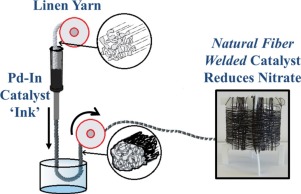当前位置:
X-MOL 学术
›
Appl. Catal. B Environ. Energy
›
论文详情
Our official English website, www.x-mol.net, welcomes your feedback! (Note: you will need to create a separate account there.)
Sustainable and scalable natural fiber welded palladium-indium catalysts for nitrate reduction
Applied Catalysis B: Environment and Energy ( IF 22.1 ) Pub Date : 2017-09-13 , DOI: 10.1016/j.apcatb.2017.09.029 David P. Durkin , Tao Ye , Jonglak Choi , Kenneth J.T. Livi , Hugh C. De Long , Paul C. Trulove , D. Howard Fairbrother , Luke M. Haverhals , Danmeng Shuai
Applied Catalysis B: Environment and Energy ( IF 22.1 ) Pub Date : 2017-09-13 , DOI: 10.1016/j.apcatb.2017.09.029 David P. Durkin , Tao Ye , Jonglak Choi , Kenneth J.T. Livi , Hugh C. De Long , Paul C. Trulove , D. Howard Fairbrother , Luke M. Haverhals , Danmeng Shuai

|
In this work, we demonstrate the production of reactive, robust, sustainable catalysts for water treatment created through Natural Fiber Welding (NFW) of lignocellulose-supported palladium-indium (Pd-In) nanoparticles onto linen yarns. First, Pd-In catalysts were synthesized by incipient wetness onto ball-milled powders of linen. Our process preserved the lignocellulose, yielding small (5–10 nm), near-spherical crystalline nanoparticles of Pd-In alloy and a uniform Pd-In metal composition throughout the fibers. Nitrate reduction tests identified the existence of an optimum Pd-In catalyst composition (5 wt% Pd and 1.2 wt% In with respect to lignocellulose) for maximum reactivity; the most reactive Pd-In catalyst was 10 times more reactive than the best performing Pd-Cu nanoparticles deposited on lignocellulose using the same approach. This improved performance was most likely due to more uniform distribution of alloyed Pd-In nanoparticles throughout the support. Nitrate reduction tests and X-ray photoelectron spectroscopy depth profiling of aged Pd-In catalysts showed that they remained stable and lost no reactivity during extended storage in air at room temperature. Next, the optimized Pd-In catalyst was fiber-welded onto linen yarns, using a custom-built yarn-coating system and a novel, scalable process that controlled catalyst loading, delivering a Pd-In catalyst coating onto the yarn surface. This fiber-welded Pd-In catalyst yarn was integrated into a novel water treatment reactor and evaluated during four months and more than 180 h of nitrate reduction tests in ultrapure water. During this evaluation, the fiber-welded catalysts maintained their reactivity with negligible metal leaching. When tested in raw or (partially) treated drinking water and wastewater, the fiber-welded catalysts were robust and stable, and their performance was not significantly impacted by constituents in the complex waters (e.g. alkalinity, organic matter). Our research demonstrates an innovative, scalable approach through NFW to design and implement robust, sustainable lignocellulose-supported catalysts with enhanced reactivity capable of water purification in complex water chemistries.
中文翻译:

可持续且可扩展的天然纤维焊接钯铟催化剂,用于硝酸盐还原
在这项工作中,我们演示了通过天然纤维焊接生产的用于水处理的反应性,坚固,可持续的催化剂的生产(NFW)的木质纤维素负载钯-铟(Pd-In)纳米颗粒到亚麻纱上。首先,通过初期润湿在球磨的亚麻粉上合成Pd-In催化剂。我们的工艺保留了木质纤维素,产生了小的(5-10 nm),近球形的Pd-In合金纳米颗粒,并且在整个纤维中形成了均匀的Pd-In金属成分。硝酸盐还原试验确定了最佳Pd-In催化剂组合物的存在(相对于木质纤维素,Pd为5 wt%,In为1.2 wt%In),具有最大的反应活性。使用相同的方法,活性最高的Pd-In催化剂的活性是沉积在木质纤维素上的最佳性能的Pd-Cu纳米颗粒的10倍。改善的性能最有可能是由于合金化的Pd-In纳米颗粒在整个载体中分布更均匀。硝酸盐还原试验和老化的Pd-In催化剂的X射线光电子能谱深度分析表明,在室温下长时间储存在空气中时,它们保持稳定并且没有反应性。接下来,使用定制的纱线涂层系统和新颖,可扩展的过程控制催化剂的负载,将优化的Pd-In催化剂纤维焊接到亚麻纱线上,从而将Pd-In催化剂涂层输送到纱线表面。将该纤维焊接的Pd-In催化剂纱线集成到新型水处理反应器中,并在超纯水中进行了四个月和超过180小时的硝酸盐还原测试,并进行了评估。在该评估期间,纤维焊接的催化剂保持了可忽略不计的金属浸出的反应性。在未经处理或(部分)处理过的饮用水和废水中进行测试时,纤维焊接的催化剂坚固,稳定,并且其性能不受复杂水域中的成分(例如碱度,有机物)的显着影响。我们的研究表明,通过NFW可以采用创新,可扩展的方法来设计和实施坚固耐用,可持续的木质纤维素负载催化剂,并具有增强的反应性,能够在复杂的水化学中进行水净化。
更新日期:2017-09-13
中文翻译:

可持续且可扩展的天然纤维焊接钯铟催化剂,用于硝酸盐还原
在这项工作中,我们演示了通过天然纤维焊接生产的用于水处理的反应性,坚固,可持续的催化剂的生产(NFW)的木质纤维素负载钯-铟(Pd-In)纳米颗粒到亚麻纱上。首先,通过初期润湿在球磨的亚麻粉上合成Pd-In催化剂。我们的工艺保留了木质纤维素,产生了小的(5-10 nm),近球形的Pd-In合金纳米颗粒,并且在整个纤维中形成了均匀的Pd-In金属成分。硝酸盐还原试验确定了最佳Pd-In催化剂组合物的存在(相对于木质纤维素,Pd为5 wt%,In为1.2 wt%In),具有最大的反应活性。使用相同的方法,活性最高的Pd-In催化剂的活性是沉积在木质纤维素上的最佳性能的Pd-Cu纳米颗粒的10倍。改善的性能最有可能是由于合金化的Pd-In纳米颗粒在整个载体中分布更均匀。硝酸盐还原试验和老化的Pd-In催化剂的X射线光电子能谱深度分析表明,在室温下长时间储存在空气中时,它们保持稳定并且没有反应性。接下来,使用定制的纱线涂层系统和新颖,可扩展的过程控制催化剂的负载,将优化的Pd-In催化剂纤维焊接到亚麻纱线上,从而将Pd-In催化剂涂层输送到纱线表面。将该纤维焊接的Pd-In催化剂纱线集成到新型水处理反应器中,并在超纯水中进行了四个月和超过180小时的硝酸盐还原测试,并进行了评估。在该评估期间,纤维焊接的催化剂保持了可忽略不计的金属浸出的反应性。在未经处理或(部分)处理过的饮用水和废水中进行测试时,纤维焊接的催化剂坚固,稳定,并且其性能不受复杂水域中的成分(例如碱度,有机物)的显着影响。我们的研究表明,通过NFW可以采用创新,可扩展的方法来设计和实施坚固耐用,可持续的木质纤维素负载催化剂,并具有增强的反应性,能够在复杂的水化学中进行水净化。



























 京公网安备 11010802027423号
京公网安备 11010802027423号